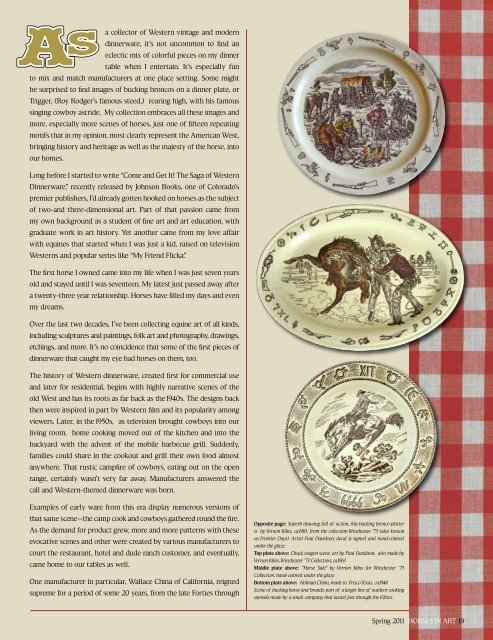a collector of Western vintage and modern - Corinne Joy Brown
a collector of Western vintage and modern - Corinne Joy Brown
a collector of Western vintage and modern - Corinne Joy Brown
Create successful ePaper yourself
Turn your PDF publications into a flip-book with our unique Google optimized e-Paper software.
a <strong>collector</strong> <strong>of</strong> <strong>Western</strong> <strong>vintage</strong> <strong>and</strong> <strong>modern</strong>dinnerware, it’s not uncommon to find aneclectic mix <strong>of</strong> colorful pieces on my dinnertable when I entertain. It’s especially funto mix <strong>and</strong> match manufacturers at one place setting. Some mightbe surprised to find images <strong>of</strong> bucking broncos on a dinner plate, orTrigger, (Roy Rodger’s famous steed,) rearing high, with his famoussinging cowboy astride. My collection embraces all these images <strong>and</strong>more, especially more scenes <strong>of</strong> horses, just one <strong>of</strong> fifteen repeatingmotifs that in my opinion, most clearly represent the American West,bringing history <strong>and</strong> heritage as well as the majesty <strong>of</strong> the horse, intoour homes.Long before I started to write “Come <strong>and</strong> Get It! The Saga <strong>of</strong> <strong>Western</strong>Dinnerware,” recently released by Johnson Books, one <strong>of</strong> Colorado’spremier publishers, I’d already gotten hooked on horses as the subject<strong>of</strong> two-<strong>and</strong> three-dimensional art. Part <strong>of</strong> that passion came frommy own background as a student <strong>of</strong> fine art <strong>and</strong> art education, withgraduate work in art history. Yet another came from my love affairwith equines that started when I was just a kid, raised on television<strong>Western</strong>s <strong>and</strong> popular series like “My Friend Flicka.”The first horse I owned came into my life when I was just seven yearsold <strong>and</strong> stayed until I was seventeen. My latest just passed away aftera twenty-three year relationship. Horses have filled my days <strong>and</strong> evenmy dreams.Over the last two decades, I’ve been collecting equine art <strong>of</strong> all kinds,including sculptures <strong>and</strong> paintings, folk art <strong>and</strong> photography, drawings,etchings, <strong>and</strong> more. It’s no coincidence that some <strong>of</strong> the first pieces <strong>of</strong>dinnerware that caught my eye had horses on them, too.The history <strong>of</strong> <strong>Western</strong> dinnerware, created first for commercial use<strong>and</strong> later for residential, begins with highly narrative scenes <strong>of</strong> theold West <strong>and</strong> has its roots as far back as the 1940s. The designs backthen were inspired in part by <strong>Western</strong> film <strong>and</strong> its popularity amongviewers. Later, in the 1950s, as television brought cowboys into ourliving room, home cooking moved out <strong>of</strong> the kitchen <strong>and</strong> into thebackyard with the advent <strong>of</strong> the mobile barbecue grill. Suddenly,families could share in the cookout <strong>and</strong> grill their own food almostanywhere. That rustic campfire <strong>of</strong> cowboys, eating out on the openrange, certainly wasn’t very far away. Manufacturers answered thecall <strong>and</strong> <strong>Western</strong>-themed dinnerware was born.Examples <strong>of</strong> early ware from this era display numerous versions <strong>of</strong>that same scene--the camp cook <strong>and</strong> cowboys gathered round the fire.As the dem<strong>and</strong> for product grew, more <strong>and</strong> more patterns with theseevocative scenes <strong>and</strong> other were created by various manufacturers tocourt the restaurant, hotel <strong>and</strong> dude ranch customer, <strong>and</strong> eventually,came home to our tables as well.One manufacturer in particular, Wallace China <strong>of</strong> California, reignedsupreme for a period <strong>of</strong> some 20 years, from the late Forties throughOpposite page: Superb drawing full <strong>of</strong> action, this bucking bronco platteris by Vernon Kilns, ca 1963, from the collection Winchester '73 (also knownas Frontier Days). Artist Paul Davidson; decal is signed <strong>and</strong> h<strong>and</strong>-coloredunder the glaze.Top plate above: Chuck wagon scene, art by Paul Davidson, also made byVernon Kilns, Winchester '73 Collection, ca 1963.Middle plate above: "Horse Sale" by Vernon Kilns for Winchester '73Collection, h<strong>and</strong>-colored under the glaze.Bottom plate above: Holman China, made in Frisco Texas, ca 1948Scene <strong>of</strong> bucking horse <strong>and</strong> br<strong>and</strong>s; part <strong>of</strong> a larger line <strong>of</strong> outdoor cookingutensils made by a small company that lasted just through the Fifties.www.HorsesInArt.com Spring 2011 Horses in in Art 19


